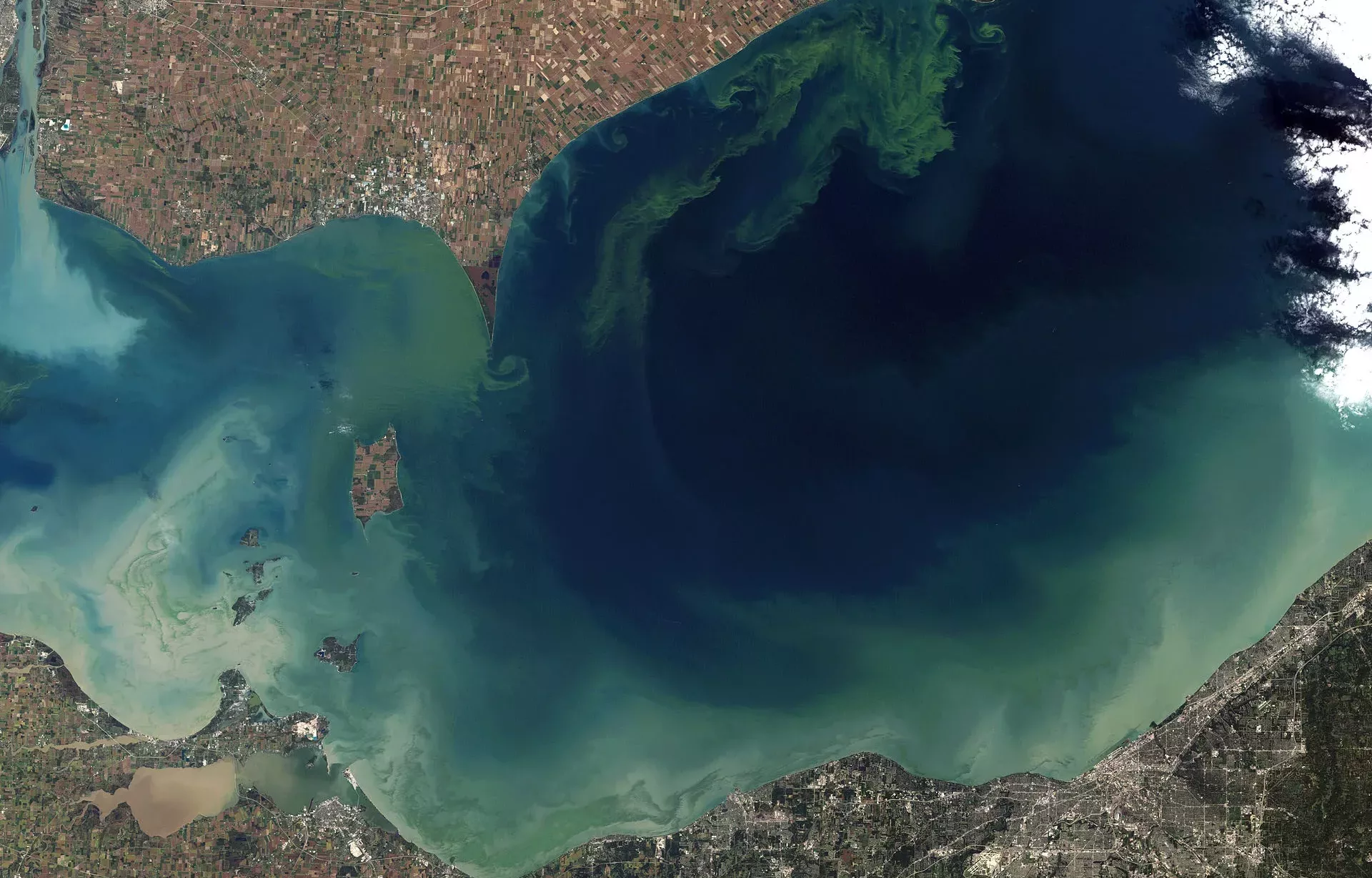Excess phosphates cause algal blooms in Lake Erie. This is only one of the issues stemming from the mismanagement of phosphate use. Image credit: NASA Earth Observatory, Wikimedia Commons.
Sitting at number 15 on the periodic table, phosphorus is widely overlooked, despite being a vital element to life on our planet. There would be no life on Earth without phosphorus, which makes up our teeth and bones, the roots and shoots of plants, and the backbone of DNA. When it comes to the mismanagement and overuse of Earth’s raw materials, oil, gas, and their associated carbon emissions, are most infamous. Phosphate usage and reserves, however, are beginning to hit critical boundaries that could shift the planet into a so-called phosphogeddon, if we are not careful.
Over a decade has passed since human alteration of the phosphorus cycle (how the element flows between natural reservoirs) has been assessed as passing a critical planetary boundary. Meaning that the cycle has been altered past the point of no return. Phosphates were declared a ‘critical raw material’ by the European Commission in 2014, highlighting the need for intergovernmental coordination and a global move towards increasing sustainable and responsible use.
Phosphate usage and reserves are beginning to hit critical boundaries that could shift the planet into a phosphogeddon.
The overuse of phosphate resources, notably as fertiliser, is a primary factor in the depletion of phosphate levels, with over 50 million tonnes of commercial phosphate fertilisers sold every year. Such overuse stems from farmers adding excess phosphates to fields ‘just in case,’ as phosphate management technology is still developing. An increasingly limited capacity to grow food, and water pollution caused by runoff from crop lands, are issues associated with this overuse.
Excess phosphates washed into bodies of water cause algal blooms (rapid growths of algae), such as the one seen in the Gulf of Mexico every summer. This creates aquatic “dead zones” through the depletion of oxygen in the water, leading to conditions where very few creatures can survive. The subsequent rate of loss of biodiversity in freshwaters is one of the highest for all planetary environments. Some of the world’s largest bodies of freshwater, such as Lake Victoria in Africa, Lake Baikal in Russia, and Lake Erie in North America are being affected. Not to mention, the death of algae produces methane, a potent greenhouse gas and contributor to global warming. The warmer climates lead to increased algal growth and ultimately a positive feedback loop. Risk to human health by drinking polluted water, and the economic impacts of algal bloom clean-ups, are further causes for concern.

Reducing phosphorus waste, especially in agriculture, will be key in managing the global phosphate cycle. Excess phosphate in agricultural soils has been estimated to be roughly a century’s supply of phosphate. Methods such as targeted injection of fertiliser into soils, or minimising use prior to heavy rainfall, have been suggested to combat this. A global shift in diets towards more plant-based produce would also reduce the need for phosphate for growing animal feed and could also play a key role in phosphate management.
As the global population continues to grow, the demand for food will rise. The planet’s population is set to reach 8.5 billion by 2030, and food will need to be grown in larger volumes. Similarly to the concept of “peak oil” formulated in the 1950s, “peak phosphorus” refers to the increasing demand for limited phosphate resources, meaning that a point will be reached where the cost to produce it will exceed the profit. This will lead to either a decline in production or an increase in price. “Peak phosphorus” is predicted to occur within the next 50 years.
One way to prevent this is by recycling. Nevertheless, it is currently limited and involves using manure or sludge from wastewater systems as cropland fertilisers, though recycling phosphate from human sewage could have a great positive impact. In 2013, Thames Water opened a plant to recover phosphate from human sewage. The current view of human and animal waste as a pollutant, however, is impacting the development of such recycling strategies. A shift towards the view of waste being a potential nutrient resource will need to be adopted, if further developments in recycling technology are to occur.
Concerns are growing over the small number of countries that can effectively control the global food supply through fertiliser production.
The mining of phosphates and the associated geopolitics may also impact fertiliser availability and subsequently global food production. Phosphates are mined from the ground in the same way ores bearing iron or copper minerals are. Only a handful of countries, however, contain sufficient resources in their bedrock to make mining economically viable. Over 70% of global reserves are found in Morocco and the Western Sahara. A further 10% are found in China, Syria, and Algeria with minor reserves in Russia, South Africa, the US, and Egypt. Norway and Finland are the only members of the EU bearing any phosphate resources, making the EU heavily dependent on its exports.
Concerns are growing over the small number of countries that can effectively control the global food supply through fertiliser production. OPEC’s (Organisation of the Petroleum Exporting Countries) 13 member states control roughly the same fraction of the world’s oil reserves as Morocco and the Moroccan occupied territory, Western Sahara, control of the world’s phosphate reserves. Effects have already been felt with the Russia-Ukraine war affecting the production of NPK (Nitrogen, Phosphorous, Potassium) fertilisers. There are worries that disputes over the control of Western Sahara may affect global fertiliser availability.

The Bou Craa mine in the Western Sahara is one of the biggest phosphate mines on the planet and can be spotted by astronauts on the ISS (International Space Station). Controversies over the Moroccan operation of the mine have caused some companies to withdraw their involvement over concerns regarding aiding Morocco’s occupation. With estimates of over 300 years’ worth of phosphate reserves left, the geological depletion of phosphate is not an immediate threat. The worry lies in how geopolitical and economic factors may impact access to reserves long before “peak phosphate” is even reached.
With a growing global population and potential increase in demand for phosphate, such as in lithium iron phosphate batteries, the future is set to be difficult for the global management of the resource. Current strategies, along with technological advancements, will need to be implemented to steer us away from a widespread food security crisis. Individuals and governments will need to cooperate. Action needs to be taken soon to save our planet from the Phosphogeddon.





